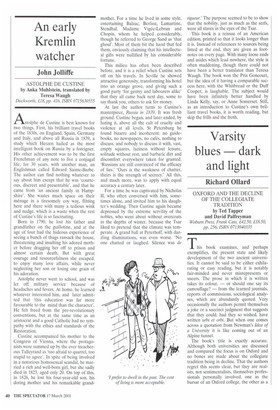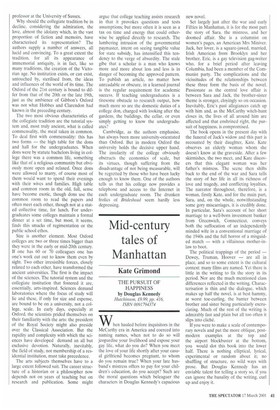Varsity blues — dark and light
Richard 011ard
OXFORD AND THE DECLINE OF THE COLLEGIATE TRADITION by Ted Tapper and David Palfreyman Woburn Press, Frank Cass, £42.50, £18.50, pp. 256, ISBN 0713040335 This book examines, and perhaps exemplifies, the present state and likely development of the two ancient universities. It cannot be said to be either exhilarating or easy reading, but it is notably fair-minded and never misrepresents or sneers. The prose in which it is written takes its colour, — or should one say its camouflage? — from the learned journals, reports of commissions, sociological analyses, which are abundantly quoted. Very occasionally the authors permit themselves a joke or a succinct judgment that suggests that they could, had they so wished, have written urbi et orbi. But when one comes across a quotation from Newman's Idea of a University it is like coming out of an Alpine tunnel.
The book's title is exactly accurate. Although both universities are discussed and compared the focus is on Oxford and no bones are made about the collegiate tradition being in decline. That the authors regret this seems clear, but they are realists, not sentimentalists, themselves professionals personally involved, one as the bursar of an Oxford college, the other as a professor at the University of Sussex.
Why should the collegiate tradition be in decline, considering the admiration, the love, almost the idolatry which, in the vast proportion of fiction and memoirs, have characterised its representation? The authors supply a number of answers, all lucid and convincing. To a great extent the tradition, for all its appearance of immemorial antiquity, is in fact, like so many traditions, the creation of the Victorian age. No institution exists, or can exist, untouched by, sterilised from, the ideas and influences of the world of its time. The Oxford of the 21st century is bound to differ from that of the 20th or the late 19th, just as the ambience of Gibbon's Oxford was not what Hobbes and Clarendon had known in the preceding century.
The two most obvious characteristics of the collegiate tradition are the tutorial system and, most truly ancient, what is called commensality, the meal taken in common. To deal first with cornmensality: this has two forms — the high table for the dons and hall for the undergraduates. When dons were by statute bachelors living in college there was a common life, something like that of a religious community but obviously more open and relaxed. Once dons were allowed to marry, of course most of them would want to spend their evenings with their wives and families. High table and common room in the old, full, sense have become exotic, though dons use the common room to read the papers and often meet each other, though not at a stated collective time, for lunch. For undergraduates some colleges maintain a formal dinner at a set time, but most, it seems, finds this smacks of regimentation or the public school ethos.
Size is another element. Most Oxford colleges are two or three times bigger than they were in the early or mid-20th century. If one has 60 or 70 colleagues one has one's work cut out to know them even by sight. Two other irresistible forces, closely related to each other, have transformed the ancient universities. The first is the impact of the sciences. The tutorial system and the collegiate institution that fostered it are, essentially, arts-inspired. Sciences demand laboratories where the focus of study will lie and these, if only for size and expense, are bound to be on a university, not a college, scale. In early days, especially at Oxford, the scientists prided themselves on their familiarity with the arts: the president of the Royal Society might also preside over the Classical Association. But the rapidity and complexity with which the sciences have developed demand an all but exclusive devotion. Naturally, inevitably, the field of study, not membership of a residential institution, must take precedence.
The arts subjects themselves have to a large extent followed suit. The career structure of a historian or a philosopher now depends not on years of teaching but on research and publication. Some might argue that college teaching assists research in that it provokes questions and tests assumptions; but more often it is seen as a tax on time and energy that could otherwise be applied directly to research. The lumbering intrusion of the governmental paymaster, intent on seeing tangible value for state subsidy, has intensified this tendency to the verge of absurdity. The stale gibe that a scholar is a man who knows more and more about less and less is in danger of becoming the approved pattern. To publish an article, no matter how unreadable or obscure, in a learned journal is the regular requirement for academic success. If teaching undergraduates is a tiresome obstacle to research output, how much more so are the domestic duties of a college don, charged with looking after the gardens, the buildings, the cellar, or even simply getting to know the undergraduates?
Cambridge, as the authors emphasise, has always been more university-orientated than Oxford. But in modern Oxford the university holds the decisive upper hand. The insularity of the college obviously obstructs the economies of scale, but its virtues, though suffering from the disadvantage of not being measurable, will be regretted by those who have been lucky enough to know them. One of the authors tells us that his college now provides a telephone and access to the Internet in each undergraduate room. The drunken frolics of Brideshead seem hardly less depressing.



































































 Previous page
Previous page